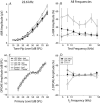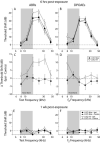Selective removal of lateral olivocochlear efferents increases vulnerability to acute acoustic injury
- PMID: 17093118
- PMCID: PMC1805782
- DOI: 10.1152/jn.00955.2006
Selective removal of lateral olivocochlear efferents increases vulnerability to acute acoustic injury
Abstract
Cochlear sensory cells and neurons receive efferent feedback from the olivocochlear (OC) system. The myelinated medial component of the OC system and its effects on outer hair cells (OHCs) have been implicated in protection from acoustic injury. The unmyelinated lateral (L)OC fibers target ipsilateral cochlear nerve dendrites and pharmacological studies suggest the LOC's dopaminergic component may protect these dendrites from excitotoxic effects of acoustic overexposure. Here, we explore LOC function in vivo by selective stereotaxic destruction of LOC cell bodies in mouse. Lesion success in removing the LOC, and sparing the medial (M)OC, was assessed by histological analysis of brain stem sections and cochlear whole mounts. Auditory brain stem responses (ABRs), a neural-based metric, and distortion product otoacoustic emissions (DPOAEs), an OHC-based metric, were measured in control and surgical mice. In cases where the LOC was at least partially destroyed, there were increases in suprathreshold neural responses that were frequency- and level-independent and not attributable to OHC-based effects. These interaural response asymmetries were not found in controls or in cases where the lesion missed the LOC. In LOC-lesion cases, after exposure to a traumatic stimulus, temporary threshold shifts were greater in the ipsilateral ear, but only when measured in the neural response; OHC-based measurements were always bilaterally symmetric, suggesting OHC vulnerability was unaffected. Interaural asymmetries in threshold shift were not found in either unlesioned controls or in cases that missed the LOC. These findings suggest that the LOC modulates cochlear nerve excitability and protects the cochlea from neural damage in acute acoustic injury.
Figures









Comment in
-
Role for the lateral olivocochlear neurons in auditory function. Focus on "Selective removal of lateral olivocochlear efferents increases vulnerability to acute acoustic injury".J Neurophysiol. 2007 Feb;97(2):963-5. doi: 10.1152/jn.01223.2006. Epub 2006 Dec 20. J Neurophysiol. 2007. PMID: 17182904 No abstract available.
References
-
- Adams JC. Sound stimulation induces Fos-related antigens in cells with common morphological properties throughout the auditory brainstem. J Comp Neurol. 1995;361:645–668. - PubMed
-
- Arnold T, Oestreicher E, Ehrenberger K, Felix D. GABAA receptor modulates the activity of inner hair cell afferents in guinea pig cochlea. Hear Res. 1998;125:147–153. - PubMed
-
- Brown MC. Morphology of labeled efferent fibers in the guinea pig cochlea. J Comp Neurol. 1987;260:605–618. - PubMed
Publication types
MeSH terms
Substances
Grants and funding
LinkOut - more resources
Full Text Sources

